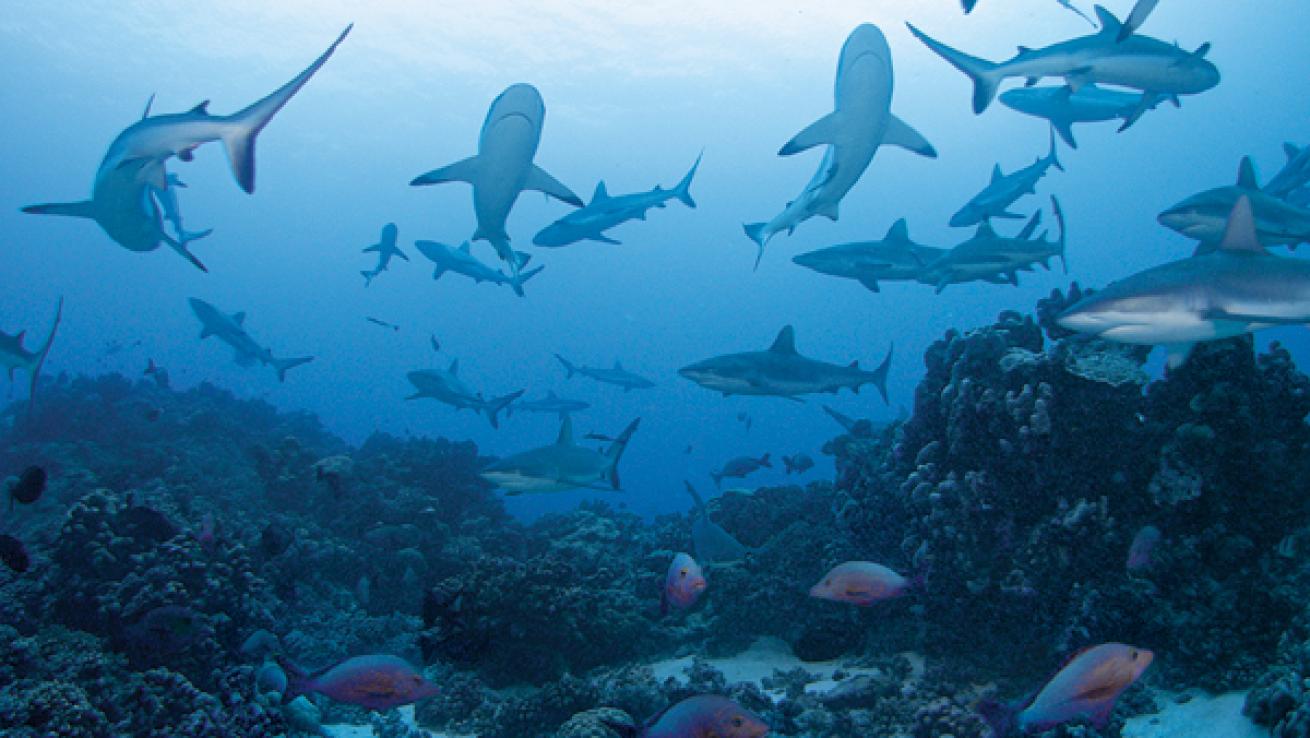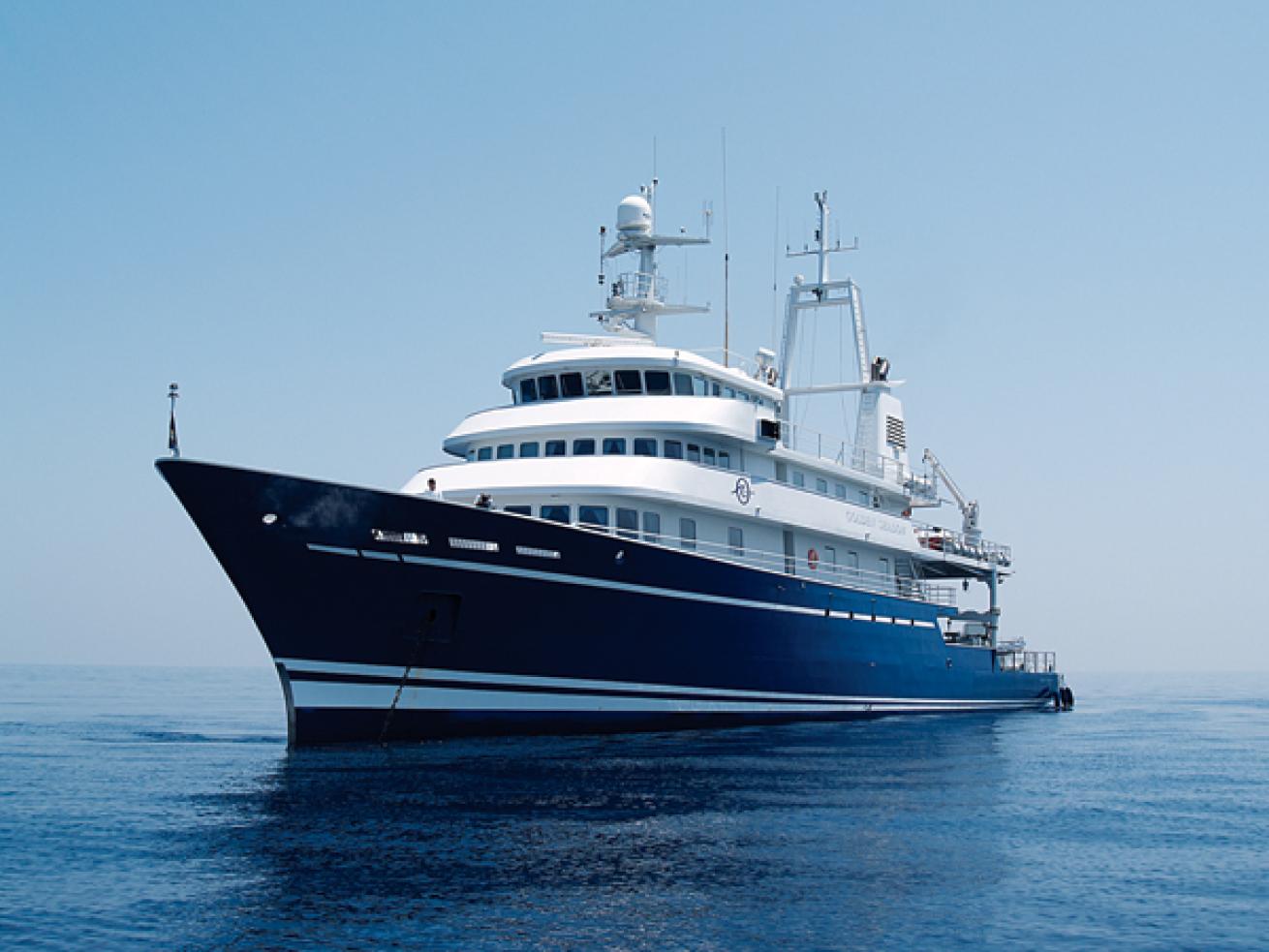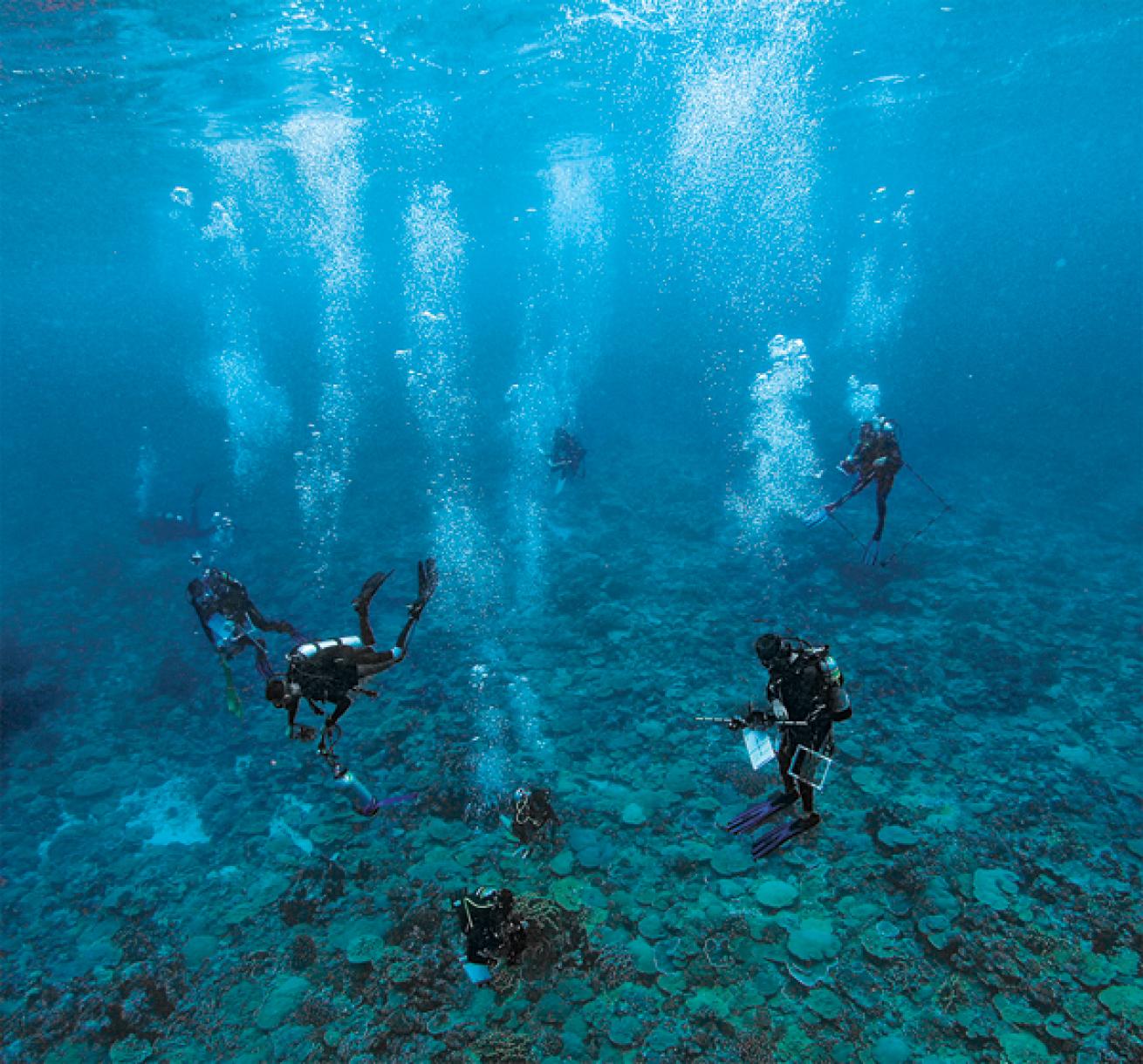Ocean Planet: Living Oceans Foundation's Harvest of Hope

A determined pack of scientific divers carries out final checks before rolling back into the clear water of the south channel of Fakarava atoll, French Polynesia. Sharks crowd the channel — literally hundreds of blacktip, whitetip and gray reef sharks speed through the underwater canyon.
As impressive as the abundance of sharks is, the divers head straight for the bottom, 75 feet below. Dangling from their BCs are white plastic rectangles wound up with lead-weighted rope, 100-foot rolling tape measures, and strange looking T-bars marked with white and black tape. In addition, each diver carries an assortment of snippersand bags, clipboards and waterproof paper, not to mention the odd piece of fancier equipment, like the PAM fluorometer, an instrument designed to measure how much fluorescent light a coral emits.
They need this equipment to carry out one of the most comprehensive coral-reef surveys ever undertaken, the Global Reef Expedition. It’s an ambitious research initiative directed by the Khaled bin Sultan Living Oceans Foundation (livingoceansfoundation.org), a nonprofit foundation dedicated to coral-reef research and conservation. Its mission: to discover how coral reefs across the world are faring in today’s changing ocean climate, and what can be done to help corals survive in the warmer, more acidic oceans of the future.
Once on the bottom of the channel, the divers fan out, staking their claim to a section of the reef and furiously recording as much data as they can before the tide turns. That tide is inconvenient: With each turn, millions of gallons of water rush from the open ocean into the center of the atoll, and back out again a few hours later. The current charges through the channels at about 1.5 to 2 knots, and the scientists must drift while they work. If they’re not diving on the inbound tide, they’ll be pulled down and far out into the Pacific.

The currents draw the sharks and an astonishing variety of other marine life into the south channel of Fakarava. The scientists take note of thousands of corals carpeting the walls and floor of the channel, some shaped like plates, others like brains, and still others like massive boulders, hundreds of years old. Schools of tiny neon-blue fish dart into the protective arms of a branching coral as the researchers swim past, logging a vast variety of fish species. An exceptional sighting: endangered humphead wrasses, more than three feet long. The researchers have never seen this many anywhere.
And that’s saying something. Since the six-year expedition got under way in 2011, these scientists have logged more than 3,500 scientific dives on reefs in the Bahamas, Colombia, the Galapagos Islands and other places. At the end of this research voyage, the foundation will analyze the data and give a report to the French Polynesian government. This will help the government decide how to protect reefs in the future. Similar reports have already helped to create new marine protected areas in the Bahamas and Jamaica.
At Fakarava atoll, the divers pack their gear and ascend slowly through the veil of sharks, this time pausing to admire these supreme predators, which appear oblivious to the now-strengthening current. Taking a last look for small creatures like shrimp, sea cucumbers and starfish, the divers surface and climb back onto the dive boat. All agree that in the south pass of Fakarava atoll they have found what they have been searching for over the past two years of the Global Reef Expedition: a virtually pristine reef, a vibrant ecosystem teeming with life, the best reef they have ever dived, and a hopeful sign for coral conservation across the world.

How to get involved
Help protect coral reefs by being responsible when you eat seafood. Avoid eating herbivorous fish like parrotfish and long-lived species like grouper. Don’t order these fish in restaurants, especially when you are overseas on diving vacations. Visit the Khaled bin Sultan Living Oceans Foundation at livingoceansfoundation.org to:
**1. **Receive field updates, photos and new discoveries from the Global Reef Expedition science team by registering online. You can also follow along via Facebook and Twitter.
2. If you are an educator, apply to join Living Oceans Foundation’s CREW (Coral Reef Educator on the Water). CREW members join an expedition and report back to their classrooms from the sea.
**3. **If you are a doctoral or postdoctoral student working in a relevant field, apply for a research fellowship. Find the fellowship guidelines at the website above, and apply online.
Alison Barrat is director of communications for the Khaled bin Sultan Living Oceans Foundation, based in Washington, D.C.

..
A determined pack of scientific divers carries out final checks before rolling back into the clear water of the south channel of Fakarava atoll, French Polynesia. Sharks crowd the channel — literally hundreds of blacktip, whitetip and gray reef sharks speed through the underwater canyon.
As impressive as the abundance of sharks is, the divers head straight for the bottom, 75 feet below. Dangling from their BCs are white plastic rectangles wound up with lead-weighted rope, 100-foot rolling tape measures, and strange looking T-bars marked with white and black tape. In addition, each diver carries an assortment of snippersand bags, clipboards and waterproof paper, not to mention the odd piece of fancier equipment, like the PAM fluorometer, an instrument designed to measure how much fluorescent light a coral emits.
They need this equipment to carry out one of the most comprehensive coral-reef surveys ever undertaken, the Global Reef Expedition. It’s an ambitious research initiative directed by the Khaled bin Sultan Living Oceans Foundation (livingoceansfoundation.org), a nonprofit foundation dedicated to coral-reef research and conservation. Its mission: to discover how coral reefs across the world are faring in today’s changing ocean climate, and what can be done to help corals survive in the warmer, more acidic oceans of the future.
Once on the bottom of the channel, the divers fan out, staking their claim to a section of the reef and furiously recording as much data as they can before the tide turns. That tide is inconvenient: With each turn, millions of gallons of water rush from the open ocean into the center of the atoll, and back out again a few hours later. The current charges through the channels at about 1.5 to 2 knots, and the scientists must drift while they work. If they’re not diving on the inbound tide, they’ll be pulled down and far out into the Pacific.

..
The currents draw the sharks and an astonishing variety of other marine life into the south channel of Fakarava. The scientists take note of thousands of corals carpeting the walls and floor of the channel, some shaped like plates, others like brains, and still others like massive boulders, hundreds of years old. Schools of tiny neon-blue fish dart into the protective arms of a branching coral as the researchers swim past, logging a vast variety of fish species. An exceptional sighting: endangered humphead wrasses, more than three feet long. The researchers have never seen this many anywhere.
And that’s saying something. Since the six-year expedition got under way in 2011, these scientists have logged more than 3,500 scientific dives on reefs in the Bahamas, Colombia, the Galapagos Islands and other places. At the end of this research voyage, the foundation will analyze the data and give a report to the French Polynesian government. This will help the government decide how to protect reefs in the future. Similar reports have already helped to create new marine protected areas in the Bahamas and Jamaica.
At Fakarava atoll, the divers pack their gear and ascend slowly through the veil of sharks, this time pausing to admire these supreme predators, which appear oblivious to the now-strengthening current. Taking a last look for small creatures like shrimp, sea cucumbers and starfish, the divers surface and climb back onto the dive boat. All agree that in the south pass of Fakarava atoll they have found what they have been searching for over the past two years of the Global Reef Expedition: a virtually pristine reef, a vibrant ecosystem teeming with life, the best reef they have ever dived, and a hopeful sign for coral conservation across the world.

..
How to get involved
Help protect coral reefs by being responsible when you eat seafood. Avoid eating herbivorous fish like parrotfish and long-lived species like grouper. Don’t order these fish in restaurants, especially when you are overseas on diving vacations. Visit the Khaled bin Sultan Living Oceans Foundation at livingoceansfoundation.org to:
**1. **Receive field updates, photos and new discoveries from the Global Reef Expedition science team by registering online. You can also follow along via Facebook and Twitter.
2. If you are an educator, apply to join Living Oceans Foundation’s CREW (Coral Reef Educator on the Water). CREW members join an expedition and report back to their classrooms from the sea.
**3. **If you are a doctoral or postdoctoral student working in a relevant field, apply for a research fellowship. Find the fellowship guidelines at the website above, and apply online.
Alison Barrat is director of communications for the Khaled bin Sultan Living Oceans Foundation, based in Washington, D.C.










